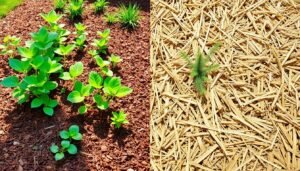You can make healthy wraps with overgrown kale. Add it to soups and sauces. Or blend it into smoothies. You can also turn large leaves into tacos or burritos. Even bake kale chips for a crunchy snack
Standing in my garden, I feel proud of my kale plants. They grow well under the sun. But, sometimes we have more kale than we can eat.
Instead of throwing it away, I look for new ways to use it. This article shows five fun ways to use overgrown kale. We’ll make tasty meals and cut down on waste.
Key Takeaways
- About 70% of homegrown produce is eaten fresh, 20% is preserved.
- Kale is full of vitamins A, B6, K, and C.
- There are many ways to cook overgrown kale.
- Good care makes kale plants last for months.
- Using overgrown kale creatively can make meals better and reduce waste.
Table of Contents
The Beauty of Overgrown Kale in My Garden
Overgrown kale adds beauty to my garden. Its leaves are dramatic and deep green. They stand out against other plants.
This kale is tough and doesn’t need much care. It stays strong even when it’s hot. Other greens may fade, but not my kale.
Every time I visit my garden, I love my kale more. They show how useful something extra can be. They’re perfect for cooking and look great too.
My kale teaches me to appreciate nature’s gifts. It makes my garden look better and reminds me to let plants grow. It’s a joy to have in my garden.
For more gardening tips, I check this website. It keeps me learning and excited about gardening.
Understanding What to Do with Overgrown Kale
I often have a lot of kale and wonder what to do with it. Looking closely at the plants shows their growth stage. Young kale is tender and sweet, while older leaves are more robust.
Older kale isn’t a waste. With the right methods, it can make delicious meals. It also opens up new gardening chances.
Cooked kale has fewer calories than raw kale. But cooking can reduce its nutrients. A pound of raw kale cooks down to about two cups, making it easy to add to dishes.
Choosing the right kale varieties is key. ‘Dwarf Blue Curled Scotch’ is great in cold months. ‘Lacinato’ has unique black leaves. ‘Red Russian’ adds a reddish-purple color, and ‘Winterbor’ is very hardy.
To enjoy kale all season, I plant it right. I sow seeds in compost-rich soil and thin them for growth. I pick outer leaves to let inner ones grow. Keeping pests away helps my plants thrive, letting me find new ways to use old kale.
| Kale Variety | Color Description | Cold Resistance | Flavor Profile |
|---|---|---|---|
| Dwarf Blue Curled Scotch | Green | High | Sweet |
| Lacinato | Dark Blue-Green | Moderate | Sweet and Mild |
| Red Russian | Reddish-Purple | Moderate | Earthy |
| Winterbor | Green | Very High | Pungent |
Creative Culinary Uses for Mature Kale

Overgrown kale opens up a world of culinary possibilities. I love turning mature kale leaves into innovative meals. These meals are both nutritious and delicious. From hearty wraps to vibrant soups, the uses for kale are endless.
These recipes highlight the unique flavors of overgrown kale. They also help reduce waste in my kitchen.
Delicious Overgrown Kale Recipes
One of my favorite recipes is kale and feta bread. It makes 12 delightful slices. The mix of erine, whole wheat flour, and Tuscan kale adds richness and flavor.
| Ingredient | Quantity |
|---|---|
| Einkorn all-purpose flour | 1.5 cups |
| Whole wheat white flour | 1 cup |
| Baking powder | 1.5 tablespoons |
| Kosher salt and black pepper | Generous pinch |
| Shredded Tuscan kale | 2.5 cups |
| Crumble feta | 1 cup |
| Eggs | 2 |
| Extra virgin olive oil | 0.5 cup |
| Plain Greek yogurt (2% or full fat) | 0.75 cup |
| Whole milk | 0.75 cup |
| Chopped walnuts (optional) | 0.25 cup |
To make the bread, I preheat the oven to 350°F. I mix the dry ingredients and kale with feta. Then, I whisk the wet ingredients and combine them all. I put it in a loaf pan and bake for 45-50 minutes.
This yields a delightful bread perfect for sandwiches or snacking.
Transforming Recipes with Large Kale Leaves
Using large kale leaves can change typical recipes. I often use blanched kale leaves instead of tortillas for tacos or burritos. This adds nutrition and a unique flavor.
Steaming or sautéing the leaves makes them softer. This makes them even more enjoyable.
In my kitchen, kale chips seasoned with nutritional yeast or spices are a crunchy snack. Each experiment with overgrown kale recipes offers nutritious options. It ensures nothing goes to waste from my kale plant care. This creativity keeps my meals exciting and healthy, allowing me to enjoy the bounty from my garden.
Preserving Overgrown Kale for Winter Months
As autumn comes, I focus on saving overgrown kale for winter. This cuts down on waste and keeps me stocked with healthy greens. Blanching kale is a key part of my routine. It stops enzymes from breaking down, keeping the kale’s color, taste, and nutrients.
I spend about 30 minutes blanching a big batch. This way, I can enjoy fresh kale even when it’s not in season. For more tips, check out this resource.
The Importance of Blanching Before Freezing
Blanching is crucial for my kale care. It helps the leaves last longer by slowing down nutrient loss. After cooling, I pack the kale tightly in freezer bags to prevent freezer burn.
This careful storage keeps my kale fresh for winter soups and casseroles. I label each bag with the date and use, making meal planning easier.
Storage Methods to Keep Kale Fresh
Keeping kale fresh is all about the right storage. I often portion out my preserved kale for easy access. Here are some storage methods and their benefits:
| Storage Method | Advantages | Disadvantages |
|---|---|---|
| Freezing | Retains flavor and nutrients; long shelf life | Requires blanching; may lose texture over time |
| Canning | Convenient for long-term storage | Can alter flavor; needs proper equipment |
| Drying | Space-saving; retains flavor | Requires special equipment; may lose some nutrients |
Using these storage methods, I can enjoy my kale all winter. This means I can make tasty, healthy meals even when fresh kale is scarce.
Utilizing Kale in Daily Meals
Adding kale to my meals makes cooking fun and healthy. It’s great for soups or side dishes. Kale makes my food taste better and is good for me.
Yummy Soup Ideas Featuring Kale
I love making a soup with kale, beans, and veggies. My favorite is a spicy Italian sausage and kale soup. It has coconut milk for creaminess.
The kale adds flavor and nutrition. Making lots of it helps me prep meals for the week.
Quick Sauté Recipes for Busy Days
When I’m in a rush, I make quick sautéed kale. I chop the kale and sauté it with garlic and olive oil. Then, I add lemon juice and red pepper flakes.
This makes kale tasty and keeps its nutrients. It’s great with grains or protein. It’s a simple way to get more greens.
Using big kale leaves in recipes is smart. It cuts down on waste and shows kale’s value in cooking. Trying overgrown kale recipes brings new tastes and textures to my meals.
| Recipe | Main Ingredients | Servings |
|---|---|---|
| Kale and Bean Soup | Kale, beans, coconut milk, sausage | 4 |
| Sautéed Kale | Kale, garlic, olive oil, lemon juice | 4 |
Dealing with Bolting Kale Plants

Understanding how climate and plant development interact is key to dealing with bolting kale. Bolting happens when kale flowers and makes seeds due to temperature changes. This usually starts when it gets too cold, below 50 degrees Fahrenheit.
This change makes the leaves taste and feel different. They become less tasty, especially when it’s hot.
To prevent this, I plant kale at the right time. I seed them six to eight weeks before the last frost. This way, they don’t bolt in their first growing season.
When they have about eight leaves, I transplant them. This helps them avoid cold damage.
Using black plastic or row covers keeps the soil warm. It also protects the plants from temperature changes. Choosing varieties like Red Ursa, Premier, or Vates also helps prevent bolting in summer.
If my kale starts to bolt, I quickly pick the leaves. I use them in dishes to make the most of them. Soaking the leaves in water for 20 minutes helps remove bitterness.
This trick not only saves the greens but also keeps them fresh longer. I store them in ziplock bags.
Kale Plant Care Strategies for Healthy Greens
To get the best out of kale plant care, I use a few key strategies. One important thing is to keep the soil pH between 6.0 and 7.5. This helps kale get the nutrients it needs.
When planting new kale seeds, I plant them about 1/4 to 1/2 inch deep. If starting with seedlings, it’s important to move them outside after 7 to 10 days of getting used to the outdoors.
Watering regularly is key, especially when it’s dry. I water at least once a week to keep the soil moist. Putting organic mulch around the kale plants helps keep moisture in and weeds out.
It’s important to thin out seedlings when they’re about 3-4 inches tall. Leave about 12-18 inches between each plant. This helps them grow well and get enough air.
I also add heated compost in spring and fall to my garden. In the summer, I use compost tea every month. Adding mycorrhizal fungi at planting time helps the roots grow strong.
For pests, I use neem or Bt insecticides. They keep pests away without harming good bugs. I watch for weeds and deal with them before planting and often during the season. Using compostable mulch helps keep weeds away.
I also plant things that help keep pests away and attract good bugs. Putting a fence around the garden keeps rabbits and deer out. These steps help my kale grow well and stay healthy.
Harvesting Mature Kale Without Waste
Harvesting mature kale is key to keeping plants healthy and getting the most from them. I make sure to pick every leaf to avoid waste. I start by picking leaves from the bottom, letting the top ones keep growing.
Tips for Efficient Harvesting
Getting ready to harvest kale is important. Use sharp, clean tools to avoid bruising the leaves. Each time you harvest, check the plants for any problems. Here are more tips for harvesting kale well:
- Choose the right time of day, ideally in the morning when the leaves are crisp and full of moisture.
- Harvest larger outer leaves first while leaving the inner leaves to grow for future harvests.
- Use a basket or container to collect leaves, reducing the need for multiple trips to the garden.
- Always handle leaves gently to maintain their freshness and quality.
By using these tips, I keep my kale garden strong. This way, I get lots of kale without wasting any.
Conclusion
Exploring overgrown kale has opened new doors in my kitchen and garden. I’ve learned that nothing is wasted. This journey makes me a better gardener and cook, allowing me to share healthy meals with my family.
I’ve made tasty recipes with kale varieties like Red Russian and Siberian. I’ve also learned how to preserve kale for winter. This knowledge has made my gardening more productive, even in cold weather.
Thinking about my successes and setbacks has made me want to share what I’ve learned. I hope to teach others how to enjoy kale and harvest it efficiently. The real joy is in growing plants and the delicious meals and connections they bring.




